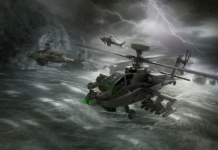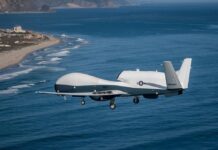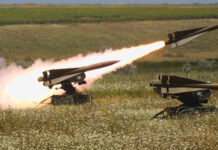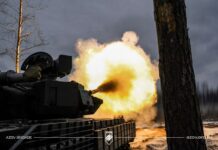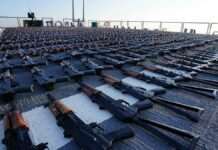This year, the state-owned defence corporation Ukroboronprom is to undergo reform. It is to be divided into two holding companies named “Defence Systems of Ukraine” and “Aerospace Systems of Ukraine”. The first holding will unite all the companies producing weapons and military equipment for the Ukrainian Army, while the second holding will combine space and aerospace. The goal is a profound reform of a key Ukrainian industry in the face of Russian aggression. ESD had the opportunity to talk to Yuriy Husyev, General Director of Ukroboronprom.
ESD: At the end of 2020, Ukroboronprom celebrated its 10th anniversary. What laid the groundwork for founding the organisation and who issued the decree?
Husyev: Indeed, Ukroboronprom was established in late 2010 as a result of administrative reforms in accordance with the Orders of the then President of Ukraine and relevant resolutions by Ukraine’s Cabinet of Ministers. At the time of the establishment of the State Concern “Ukroboronprom”, the situation in the defence industry was as follows: the dispersion of enterprises between a number of governmental bodies, insufficient efficiency of state property management, and non-efficient budget allocation. I believe this has become the main argument to shift towards market management methods in the defence industry. Therefore, the vast majority of defence enterprises were placed under the management of the state economic association known as State Concern “Ukroboronprom”. Thus, the enterprises for defence products design, manufacture and trade, both for domestic and foreign markets, came under Ukroboronprom.
At that time, it was envisaged that Ukroboronprom would see to it that the demands of Ukraine’s Armed Forces regarding the latest models of armaments, upgrades, repair, and disposal were duly met. Secondly, it was to strengthen Ukraine’s international prestige by expanding markets for competitive defence industry products. Thirdly, it was to enhance the role of the domestic defence-industrial complex in the social and economic development of the country. Indeed, this kind of vision is completely correct. It is another matter that for about 10 years, Ukroboronprom has been carrying on differently — meaning, not everything has been done. There are many reasons for this, both internal (employment issues), and external (political). In 2014, the war began in Ukraine. The needs of our army have changed, as well as the technology of warfare in the world as a whole has changed. Ukraine was faced with new challenges. In order to be able to respond, we now need to reform Ukroboronprom.
I want to emphasise that as an international partner, Ukroboronprom will not cease to exist; it will not be liquidated, but will be transformed. This is extremely important. This transformation will become a historic event for Ukraine, because the old standards will be replaced by a completely new type of defence company, meeting OECD corporate governance standards. Ukraine’s new defence complex will become a powerful player and a reliable partner on the international market of armaments and military hardware.
ESD: How many companies are now part of Ukroboronprom and what do they have to offer the international market? Can you provide turnover and income rates?
Husyev: As a State Concern, Ukroboronprom includes over 100 enterprises today, some of which are on the temporarily occupied territories, which Ukraine is definitely going to return. The development of modern models of rocket and space technology, military transport aircraft, shipbuilding, high-precision weapons, armoured and engineering equipment, reconnaissance and radio suppression, radar weapons for various purposes offer the greatest potential in Ukraine. The level of development of countries involved in aircraft building places Ukraine among the most developed countries. Only five or six high-tech countries possess an industry at this level. Some models of Antonov-type aircraft are several steps ahead of similar foreign models.
Ukraine has extensive experience in building equipment such as helicopters and aircraft carriers, in addition to civilian vessels for various purposes. Ukraine’s production and technological capabilities allow for the manufacture of vessels of various classes and purpose, with a deadweight of up to 150-180,000 tonnes. In the future, Ukraine will be capable of producing its own Naval and Merchant Navy ships. Ukraine is one of the world’s leaders in gas turbine construction. We design and manufacture gas turbines for sea vessels, for electricity and gas pipelines.
Ukraine’s armoured engineering has a single closed cycle production of modern models of tanks and armoured personnel carriers. Structurally, this branch of production is self-supporting and able to provide a cycle from development to serial production of final products. The BM OPLOT tank is the latest development, created with the use of advanced technologies and design solutions. Ukraine is among ten countries able to develop and manufacture modern missile weapons and the whole production line of high-precision weapons.
As for financial performance, I can only say that the State Concern demonstrated earnings growth in recent years. For example, the net profit for 2020 grew more than twice – to be precise, by +108.36 per cent, compared to that in 2019.
ESD: What is the average annual budget invested in research and technology by Ukraine’s defence industry? How much of the total number of workers in industry are involved in research and do these figures reflect any trend?
Husyev: It is common among all countries that defence is one of the most high-tech industries. Among the concerned entities, we have both manufacturing enterprises and over two dozen specialised design bureaus, research institutes, research and design centres. These are all research institutions whose main activity is conducting research and creating new defence technologies.
Today, on the order of Ukraine’s Defence Ministry, Ukroboronprom’s scientific institutions conduct dozens of state design works to create the latest models of weapons and military hardware, specifically, in the field of high-precision missiles, innovative radar stations, and new models of armoured vehicles. In total, for these purposes in 2021, the Defence Ministry allocated to our enterprises about 5 per cent of the state defence order (over UAH 1Bn or about US$35M).
At the same time, all our enterprises also carry out internal research and development. After all, ammunition production never stands still, and a lot of things change quickly. Workbenches, machine tools and other equipment are being improved. And in order to change some of the smallest details in a serial model of armament or to implement a small detail in new equipment to reduce the cost of production, the company must conduct research at all the relevant stages, tests and financial costs.
Usually, experience shows that Ukrainian manufacturing defence companies try to invest about 10 per cent of their profits in government design work. In turn, scientific institutions of the defence industry complex allocate at least 70 per cent for these purposes. That is, with the growth of production of the Ukrainian defence industry, the volume of investments in research, innovation and technology will grow proportionally.
At the same time, we have already started reforming Ukroboronprom and plan to become a driver of scientific, technical and innovative development of the defence industry. This year, we will recommence with the operation of the Council for Scientific and Technical Development and Innovations of Ukroboronprom, which includes the most recognised experts in Ukraine’s defence industry, science and innovation community. The work of this Council will contribute to the large-scale reshaping of the way new types of weapons and military hardware are created.
ESD: How many clients outside Ukraine does Ukroboronprom maintain business relations with? Can you provide examples of current programmes?
Husyev: In 2020, companies of the State Concern exported weapons, military hardware and services to almost 50 countries. In total, over 70 countries are partners of Ukroboronprom in the global arms market. Today, we are active in negotiations in order to expand cooperation in the field of guided missile weapons and anti-tank missile systems.
For the first time, Ukroboronprom’s enterprises signed large-scale contracts for the supply of missiles and high-precision weapons to a number of countries in the Middle East and North Africa, won a tender and launched contracts for the supply of anti-tank missile kits to one Asian-Pacific country. Latin American countries, who have significantly increased the activities of their domestic enterprises, are also included among those important programmes. Indeed, we have increased our own presence in the Peruvian market after we signed a contract for the construction of the An-178 aircraft. We are participating in a number of major tenders to supply Ukrainian military goods, as well as provide relevant services. We are also working to strengthen our position in the aviation markets of Latin America and Asia.
A large contract for the construction of a light armoured vehicle repair plant is underway in one of the countries of the Asia-Pacific region. We are continuing with our cooperation with Turkey, supplying aircraft engines and providing technical support of the integration of engines into UAV systems. Today, the top five products of the State Concern are as follows:
1. Ship gas turbine engines and units, equipment for Navy hardware;
2. Manufacture and repair of aircraft engines;
3. Anti-tank missile systems and missiles for them;
4. The GURT system;
5. Repair and modernisation of aircraft.
ESD: To what extent is the Ukrainian defence industry able to meet the needs of the Ukrainian Armed Forces? Are there areas where you have to rely on foreign suppliers?
Husyev: For the team of Ukroboronprom and for me as the head of the State Concern, meeting the needs in armaments and military equipment of Ukraine’s Armed Forces and other law enforcement agencies is a priority. This is our mission. Thus, last year, Ukroboronprom’s enterprises fulfilled 100 per cent of contracts under the state defence order. No disruptions, no delays. On the contrary, every fifth contract was executed ahead of schedule.
If we talk about numbers — 46 of our companies that have fulfilled 55 contracts under the 2020 state defence order are ahead of schedule. Given the external threats and the situation near the state borders, the Concern has analysed its capabilities and we are ready to produce twice as much weaponry and military hardware to be ordered by our country, if necessary. Some of the needs of our Army are met by private manufacturers and our foreign partners; I mean the countries with whom we have friendly relations apart from the contractual links. And we are grateful to them for the opportunity to receive modern weapons that meet NATO standards. France, [the] UK, Germany, Denmark, Israel, Turkey, the Czech Republic, Poland, Latvia, Lithuania, Cyprus, Canada and the United States made up the arms suppliers for Ukraine’s security forces in 2014 – 2020.
ESD: In your opinion, what technological industries are most likely to demonstrate the biggest growth of potential to lay the groundwork for Ukraine’s defence industry and why?
Husyev: Today, most of Ukraine’s partner countries are changing their options towards military-technical cooperation. Specifically, from the direct purchase of weapons to the use of offset schemes, the purchase of technologies, creation of joint projects or deployment of domestic weapons production.
There are changes underway in the structure of arms supplies in the world: there is a steady increase in demand for combat aircraft, naval equipment, air defence and unmanned systems. Speaking globally, today we are witnessing and participating in very rapid changes – fundamental changes in the paradigm and technology of warfare itself. The age of fighter jets is gone. The future lies with wars between drones and unmanned systems. I am sure that in the coming decades we will see a growth in production of robotic systems that will independently determine the target, track it and strike it. They will analyse the data themselves and assess the consequences of their strikes.
Our global challenge today is how to educate a new generation of engineers and designers to work with weapons of the future. And I think it’s right to bet on that. Ukroboronprom has already begun cooperating with the leading higher education institutions of Ukraine. We are investing in a new generation – a new generation of professionals who will work in the country’s defence industry tomorrow. The next step is to launch educational training programmes together with leading international educational institutions.
ESD: Can Ukraine’s defence industry now offer European quality at lower prices than Western ones?
Husyev: The State Concern’s enterprises have developed many innovations that have significant potential in the international market for armaments and military equipment. For example, the VILKHA multiple launch rocket system and missiles for them, the NEPTUNE coastal missile defence system, An-178/188 aircraft, a line of new combat modules, armoured combat vehicles of the new generation based on the modular concept, anti-tank missile systems, strike and reconnaissance drones, aircraft engines, gas turbine units for marine equipment and many others.
Besides, one of the main products of Ukraine’s defence industry is providing services for repair and modernisation of weapons and military hardware. Ukraine is one of the few countries able to repair and modernise almost any piece of hardware produced in the Soviet Union. It is a unique and popular product, which is in steady demand.
The interview was conducted by Jürgen Hensel and originally appeared in the July issue of European Security & Defence. Click here to download the full issue in PDF format.







